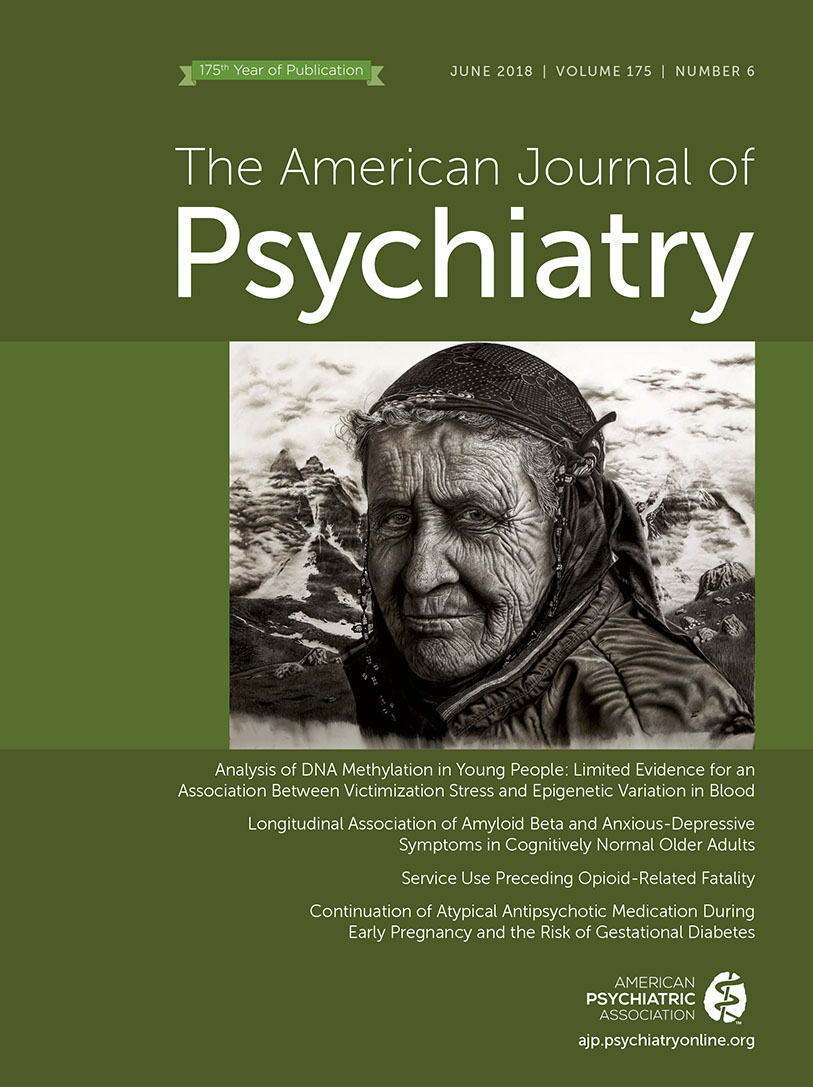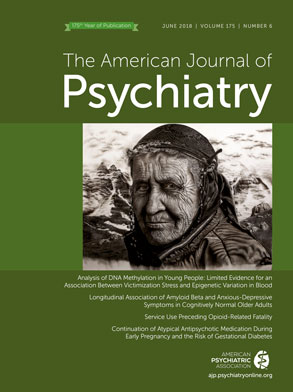Is early exposure to adversity associated with a genetic or an epigenetic signature? At first glance, two articles in this issue—one from Peterson et al. (
1), who conducted a genome-wide association study for depression in a large sample of women ages 30–60, and the other from Marzi et al. (
2), who measured genome-wide DNA methylation in a prospective twin cohort assessed at age 18—appear to say that it is not. Peterson et al. found that the occurrence of recurrent depression was associated with five genetic loci, but only in women who did not report a history of childhood adversity. In depressed women who did report early adversity, no loci were detected. These findings could lead a reader to the premature conclusion that depression with adversity is “nongenetic” and, by extension, that adversity is not associated with genetic antecedents. Similarly, Marzi et al. found no epigenetic signal in association with childhood victimization, as evaluated in real time at ages 5, 7, 10, 12, and 18. Interestingly, using retrospective reports of childhood victimization collected at age 18, two probes were identified, although co-twin analyses did not show an association between these probes and victimization severity. Marzi and colleagues’ observations might lead to the conclusion that victimization is not affected by, nor does it affect, the epigenome. A second glance, however, leads to a different understanding of these findings.
The first point to highlight is that a failure to identify a genetic or an epigenetic signature of victimization in a main effect analysis does not mean that adversity is not associated with genetic or epigenetic markers. Rather, it might be an indication of the necessity of directly examining, and accounting for, the moderating behavioral, psychiatric, and health effects of victimization. Thirty years of focused work on biological effects of trauma has shown that the subjective impact and biobehavioral consequences of trauma exposure—not just its presence or severity—must be considered in any investigation of biological associations with trauma exposure (
3,
4). Indeed, victimization experiences predicted poor psychiatric outcomes in the same cohort (
5) that Marzi et al. report on here, raising the possibility that the inclusion of those variables may have yielded a methylation signal in specific subtypes of victimized twins. In the Peterson et al. study, when the five loci detected in association with depression in women unexposed to childhood adversity were examined in the full sample, significant gene-by-environment interactions were observed. The combined power offered by the full data set allowed detection of such interactions at three of the five loci, suggesting that the presence of adversity greatly increased the risk for depression in carriers of the identified loci. In the literature reflecting the impact of trauma exposure on biological outcomes, there is often a graded relationship between trauma exposure with and without psychopathology, a conclusion that can be reached by the gene-by-environment interactions reported in the Peterson et al. study, albeit from a different perspective.
A second point to consider is the implication of retrospective versus prospective reporting of adversity. In the Marzi et al. study, relevant clues to the potential link between epigenetics and adversity were revealed by the observation that prospectively collected victimization data resulted in different findings relative to retrospective data. This finding could be understood to reveal the limitations of retrospectively gathered information to describe historical reality. However, it may mean that a biological marker associated with accommodation to one’s environment following victimization is not limited to what actually happened but also reflects the effects of what happened. This can include the subjective memories, the type of social supports received at the time of exposure and thereafter, and the level of current distress and concomitant circumstances. If the point of developing biological correlates of early victimization is to document that those victimizations occurred, prospective data would be more valid. However, one of the challenges of using trauma exposure data in large epidemiological studies is that the occurrence of an event may not be related to its autobiographical importance. Peterson et al. note that events that have a long-term impact may have more to do with the highly personalized features of the event than with its objective characteristics. Thus, while the study reminds us of the fragility of retrospective reports with respect to providing historical accuracy, their use in identifying biological correlates may point to the value of capturing the impact of events and identifying the factors that contextualize trauma exposure.
A third issue raised by the two studies is that the tools developed for genome-wide screening approaches may not be suitable for testing hypotheses in “candidate approaches.” Marzi et al. used a genome-wide approach with the Illumina 450 to identify potential sites of methylation that would associate with early victimization and also directly examined probes located in previously identified glucocorticoid-related genes (
6–
10). For NR3C1, no significant probes were associated with victimization, and for FKBP5, only one probe was related to retrospective reports. Thus the authors could not confirm the association of those genes with early childhood experience, despite attempts to evaluate the data in multiple ways. The authors did note that “key areas of the epigenome reported to index maltreatment exposure are sparsely covered on the Illumina array” (
2). It is worth underscoring this point because while genome-wide tools have greatly expanded our capacity for discovery, they are not designed for an understanding of the functional biology of specific genes in relation to environmental exposures. Failure to confirm findings of a comprehensive workup with a screening tool only highlights the limitations of the screening tool. The results of analyses based on sites sparsely covered on important genes cannot be used to disconfirm the results of comprehensive examinations of transcriptionally relevant intronic or enhancer regions. The question that can be asked is, At what point are biologically informed theories abandoned if they remain unsupported by evidence gathered using current genome-wide approaches in psychiatric genetics and epigenetics?
We also highlight the statement made by Peterson et al., who note that their findings “counter the dominant paradigm in psychiatric molecular genetics research that increasing sample size should be the primary method for detecting more genetic loci.” This statement charges our field with paying continued attention to individual phenotyping and subtyping, especially in the assessment of environmental adversity and its effects. Adding numbers may identify more genes, but it might not be clear what those genes are associated with if only modest attention is paid to phenotyping. Notably, Marzi et al. collected prospective reports and retrospective reports of adversity, which allowed them to examine differences in these two types of adversity.
Related to careful clinical phenotyping and thoughtful assessment of environmental exposure is the consideration of biobehavioral variables that moderate the association between genetic and molecular markers and adversity. Marzi et al. report that their results were confounded by smoking, which they describe as a “nonpsychosocial toxin” in contrast to adversity. However, smoking may not only be a behavior occasioned by adversity, it may also be a proxy for psychosocial correlates of adversity, including lower socioeconomic status and mental health symptoms. Other potential covariates of adversity, including body mass index, may reflect systemic problems, the somatic impact of stress, or even the development of medical illness. Such potential confounders may reflect signal rather than noise in any investigation of biological factors associated with adversity or victimization.
Providing a context for negative results is important, because whether or not genetic and molecular factors shape, or are shaped by, adversity has implications for our conversations about mental health and its treatment. And it also has social and political consequences regarding whether people feel stigmatized, validated, or empowered by this knowledge. The inclusion of psychological and biobehavioral outcomes in the analysis of the impact of adversity on biological signatures is critical in shaping this conversation and providing the public, and our patients, with meaningful information about the impact of adversity and potential avenues of resilience.

